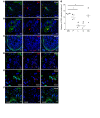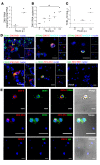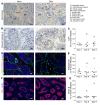Zika virus infects human testicular tissue and germ cells
- PMID: 30063220
- PMCID: PMC6159993
- DOI: 10.1172/JCI121735
Zika virus infects human testicular tissue and germ cells
Abstract
Zika virus (ZIKV) is a teratogenic mosquito-borne flavivirus that can be sexually transmitted from man to woman. The finding of high viral loads and prolonged viral shedding in semen suggests that ZIKV replicates within the human male genital tract, but its target organs are unknown. Using ex vivo infection of organotypic cultures, we demonstrated here that ZIKV replicates in human testicular tissue and infects a broad range of cell types, including germ cells, which we also identified as infected in semen from ZIKV-infected donors. ZIKV had no major deleterious effect on the morphology and hormonal production of the human testis explants. Infection induced a broad antiviral response but no IFN upregulation and minimal proinflammatory response in testis explants, with no cytopathic effect. Finally, we studied ZIKV infection in mouse testis and compared it to human infection. This study provides key insights into how ZIKV may persist in semen and alter semen parameters, as well as a valuable tool for testing antiviral agents.
Keywords: Innate immunity; Sex hormones; Urology; Virology.
Conflict of interest statement
Figures







Similar articles
-
Recombinant Chimpanzee Adenovirus Vaccine AdC7-M/E Protects against Zika Virus Infection and Testis Damage.J Virol. 2018 Feb 26;92(6):e01722-17. doi: 10.1128/JVI.01722-17. Print 2018 Mar 15. J Virol. 2018. PMID: 29298885 Free PMC article.
-
Human Testicular Germ Cells, a Reservoir for Zika Virus, Lack Antiviral Response Upon Zika or Poly(I:C) Exposure.Front Immunol. 2022 Jun 17;13:909341. doi: 10.3389/fimmu.2022.909341. eCollection 2022. Front Immunol. 2022. PMID: 35784373 Free PMC article.
-
Male germ cells support long-term propagation of Zika virus.Nat Commun. 2018 May 29;9(1):2090. doi: 10.1038/s41467-018-04444-w. Nat Commun. 2018. PMID: 29844387 Free PMC article.
-
The Cellular Impact of the ZIKA Virus on Male Reproductive Tract Immunology and Physiology.Cells. 2020 Apr 18;9(4):1006. doi: 10.3390/cells9041006. Cells. 2020. PMID: 32325652 Free PMC article. Review.
-
Apoptosis during ZIKA Virus Infection: Too Soon or Too Late?Int J Mol Sci. 2022 Jan 24;23(3):1287. doi: 10.3390/ijms23031287. Int J Mol Sci. 2022. PMID: 35163212 Free PMC article. Review.
Cited by
-
A human iPSC-array-based GWAS identifies a virus susceptibility locus in the NDUFA4 gene and functional variants.Cell Stem Cell. 2022 Oct 6;29(10):1475-1490.e6. doi: 10.1016/j.stem.2022.09.008. Cell Stem Cell. 2022. PMID: 36206731 Free PMC article.
-
Potential for Virus Endogenization in Humans through Testicular Germ Cell Infection: the Case of HIV.J Virol. 2020 Nov 23;94(24):e01145-20. doi: 10.1128/JVI.01145-20. Print 2020 Nov 23. J Virol. 2020. PMID: 32999017 Free PMC article.
-
An overview of Zika virus genotypes and their infectivity.Rev Soc Bras Med Trop. 2022 Sep 30;55:e02632022. doi: 10.1590/0037-8682-0263-2022. eCollection 2022. Rev Soc Bras Med Trop. 2022. PMID: 36197380 Free PMC article. Review.
-
Zika Virus Infection, Reproductive Organ Targeting, and Semen Transmission in the Male Olive Baboon.J Virol. 2019 Dec 12;94(1):e01434-19. doi: 10.1128/JVI.01434-19. Print 2019 Dec 12. J Virol. 2019. PMID: 31597777 Free PMC article.
-
Experimental Infection of Mid-Gestation Pregnant Female and Intact Male Sheep with Zika Virus.Viruses. 2020 Mar 7;12(3):291. doi: 10.3390/v12030291. Viruses. 2020. PMID: 32156037 Free PMC article.
References
Publication types
MeSH terms
LinkOut - more resources
Full Text Sources
Other Literature Sources
Medical
Molecular Biology Databases

